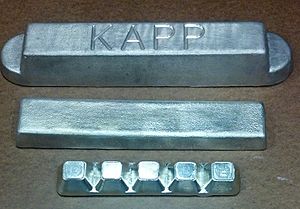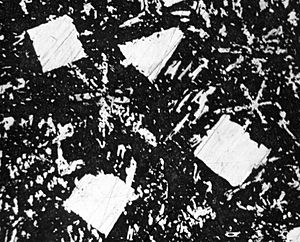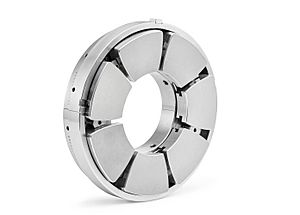Babbitt (alloy) facts for kids
Babbitt metal, also known as bearing metal, is a special type of alloy (a mix of metals) used to create smooth surfaces inside plain bearings. Bearings are parts that help other machine parts spin or slide smoothly with less friction.
This useful alloy was invented in 1839 by Isaac Babbitt in Taunton, Massachusetts, United States. He shared one of his secret recipes for the metal, but he kept others private. Over time, other similar metal mixes were developed. The name "babbitt metal" is often written with a small 'b' because it's become a common term, like "diesel engine". People prefer to call it "babbitt metal" instead of "white metal" because "white metal" can mean many different things.
Babbitt metal is usually a thin layer on top of other metals in a complex machine part. However, it was first used as a solid block of metal poured right into place to form a bearing. Babbitt metal is known for being resistant to galling, which is when two metal surfaces stick together and cause damage.
Even though babbitt metal feels soft and can be easily damaged, it's actually great for bearings! This is because it's made of tiny, hard crystals spread out in a softer metal. Think of it like a metal matrix composite. As the bearing is used, the softer metal slowly wears away a little. This creates tiny paths for lubricant (like oil) to flow between the hard spots. These hard spots are what actually support the moving part. If the softer metal is tin, the heat from friction can even melt the tin slightly, making it act as a lubricant and protecting the bearing if other oils aren't there.
Engines, especially those that burn fuel inside (like in cars), often use babbitt metal that is mostly made of tin. This type of babbitt can handle repeated pushing and pulling forces very well.
How Babbitt Bearings Are Made
In older machines, babbitt metal bearings were often made right inside the machine. Imagine a cast iron block that fits loosely around a spinning shaft. The inside of this block might have small holes to help the babbitt metal stick when it's poured.
First, the shaft is coated with soot so the babbitt won't stick to it. Then, clay is used to seal the ends of the bearing area, creating a mold. Hot, melted babbitt metal is poured into this space around the shaft, filling the bottom half of the block. After it cools, the metal is trimmed. Babbitt metal is soft enough to be cut with a knife.
A thin steel shim (a small, flat piece of metal) is placed on top of the lower bearing to protect it and create a space for the top part of the block. More clay seals the ends, and more melted metal is poured into the top part of the block through a hole. This hole will later become a place to add oil.
Once cooled, the two halves of the bearing are separated at the shim. The shim is removed, and any metal blocking the oil holes is cleared. Small grooves are cut into the surface of the new bearing to help oil flow. The shaft is then coated with a special blue dye and rotated in the bearing. When the bearing is taken apart, the blue shows where the shaft touched. The high spots are carefully scraped down, and this process is repeated until the blue dye shows an even pattern.
Finally, the bearing is cleaned, oiled, and adjusted so the shaft fits snugly but can still move freely. The bearing is then "run in" by running it slowly with lots of oil and light pressure. This finishes making the hard bearing surface ready. After a final adjustment, you get a very strong and reliable bearing!
Before electric motors became cheap, factories used central engines to power machines through long overhead shafts. These shafts ran through hundreds of babbitt bearings. Belts made of leather or fabric would then transfer this power to the working machines.
The phrase "run bearing" comes from these old bearings. If a bearing didn't get enough oil, it would get very hot from friction. This heat could melt the babbitt metal, causing it to "run" out of the block.
Modern Babbitt Bearings
Up until the mid-1950s, poured babbitt bearings were common in cars. The babbitt was poured directly into the engine block or caps. Tin-based babbitts were popular because they could handle the strong impacts from the connecting rods and crankshaft. These poured babbitt bearings were kept thin. Car parts would have shims that could be removed as the babbitt wore down. For example, old Ford Model T cars used babbitt that was mostly tin, with some copper and antimony.
These poured babbitt bearings often lasted for over 50,000 miles. They were also known to fail "gracefully," meaning they would wear out slowly without suddenly breaking the engine. A failed babbitt bearing was not likely to damage the crankshaft.
Today, the bearings for the crankshaft and connecting rods in a modern car engine are usually made differently. They use a replaceable steel shell that fits into the bearing caps. The inside of this steel shell is coated with bronze, and then a thin layer of babbitt metal is added on top to create the actual bearing surface.
The process of adding this layer of babbitt metal is called "Babbitting."
Other Types of Bearings
In many situations, other types of bearings, like ball or roller bearings, have replaced babbitt bearings. These bearings can have less friction than plain bearings. Their main advantage is that they don't always need a constant supply of pressurized oil to work well. Ball and roller bearings can also handle forces that push sideways (radial) and along the shaft (axial).
However, ball and roller bearings don't absorb shocks or vibrations as well as fluid-film bearings, like those made with babbitt metal. Babbitt bearings are better at cushioning heavy loads and sudden impacts.
See also
 In Spanish: Babbitt (metal) para niños
In Spanish: Babbitt (metal) para niños




